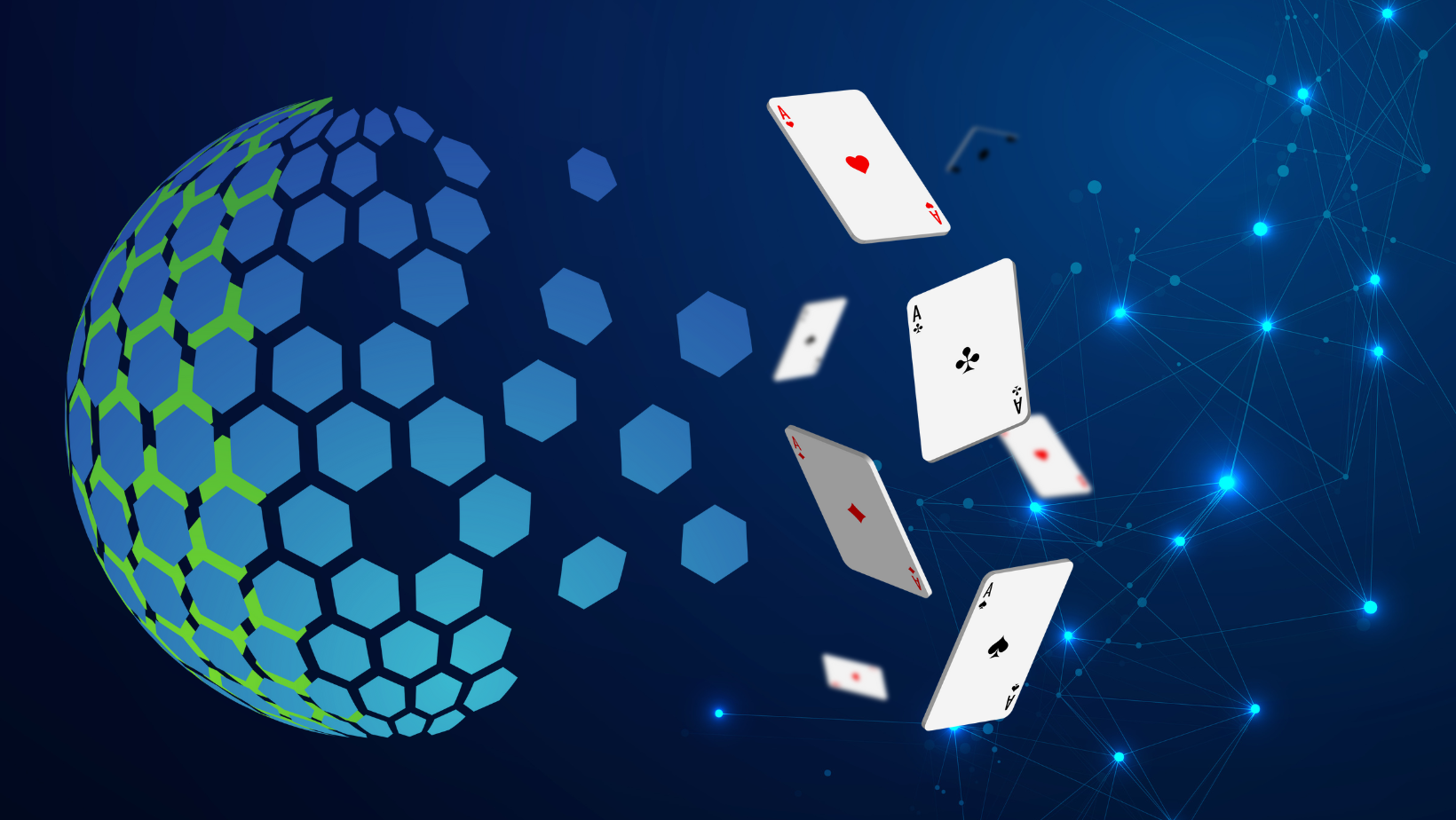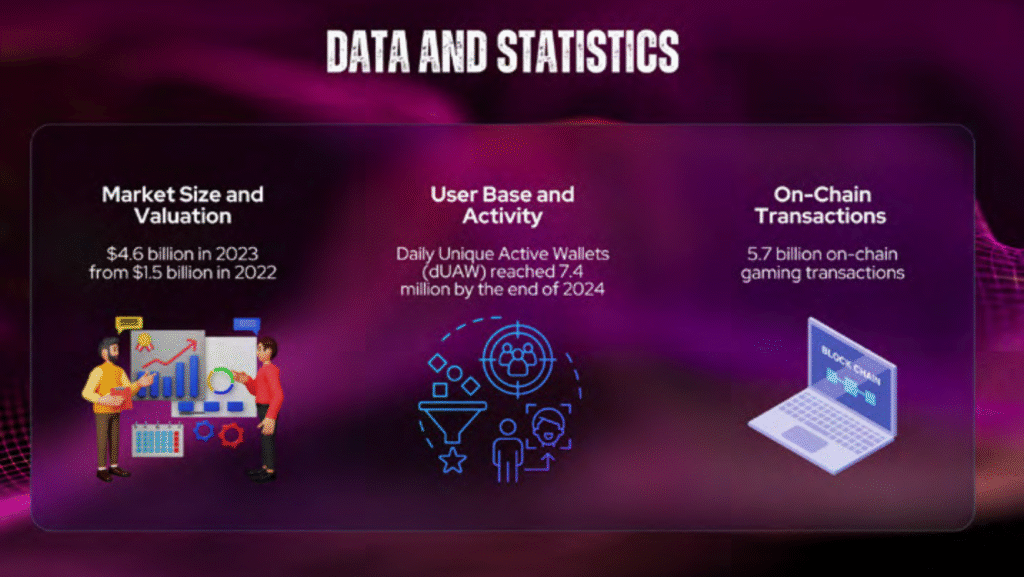0x12…qrst

The digital gold rush is in full swing as blockchain gaming explodes into a multi-billion dollar frontier, luring players with the promise of real-world riches and true asset ownership. Yet, beneath the dazzling hype, a fierce debate rages: is blockchain gaming truly revolutionizing interactive entertainment, or is this vibrant new world teetering on the brink of a speculative collapse, its future hanging precariously in the balance?
In 2023, blockchain gaming surged to a $4.6 billion market, captivating players with promises of earning real money through play-to-earn models and owning in-game assets as NFTs. But as the sector matures, a critical question emerges: Is blockchain gaming a revolutionary new frontier for the gaming industry, or is it a speculative bubble built on shaky foundations?
Blockchain gaming has emerged as one of the most polarizing and transformative movements in the digital entertainment landscape. By leveraging decentralized technologies like blockchain, non-fungible tokens (NFTs), and cryptocurrencies, this nascent industry promises to redefine how players interact with games — offering unprecedented ownership, monetization, and creative freedom.
Yet, for all its potential, blockchain gaming faces a litany of challenges, from scalability issues to economic sustainability and regulatory scrutiny. To understand the complexities of this burgeoning sector, we looked into what industry leaders, economists, and skeptics are saying about it, which allowed us to come up with a comprehensive analysis of blockchain gaming’s promise and pitfalls.
Blockchain gaming emerged as a disruptive force, blending decentralized technology with interactive entertainment. Titles like Axie Infinity and The Sandbox pioneered play-to-earn (P2E) models, allowing players to earn cryptocurrency and trade in-game assets as NFTs. By 2023, the sector accounted for 10% of the global gaming market, with over 1.5 million daily active users.

Blockchain gaming’s core appeal lies in its ability to dismantle the traditional power structures of the gaming industry. In conventional games, players invest time and money into acquiring virtual items — skins, weapons, characters — that are ultimately controlled by centralized game developers. Blockchain gaming flips this paradigm by enabling players to truly own their in-game assets through NFTs, which can be traded, sold, or transferred across platforms.
One of the most celebrated innovations in blockchain gaming is the Play-to-Earn (P2E) model, which allows players to earn cryptocurrency by participating in gameplay. Titles like Axie Infinity , developed by Sky Mavis, have become poster children for this model.
Players breed, battle, and trade Axies — digital creatures represented as NFTs — and earn Smooth Love Potion (SLP) tokens in the process. These tokens can be exchanged for real-world value, creating opportunities for income generation, particularly in developing economies.
In the Philippines, Axie Infinity became a lifeline during the pandemic, with some players earning more than local minimum wages by playing the game. According to a 2022 report by Yield Guild Games (YGG), over 1 million active players in Southeast Asia relied on P2E games as a primary source of income.
Beyond P2E, blockchain gaming has given rise to thriving NFT marketplaces where players can buy, sell, and trade in-game assets. Platforms like OpenSea , Magic Eden , and Immutable X Marketplace have facilitated billions of dollars in transactions. For instance, virtual land in The Sandbox has generated over $500 million in sales , while rare skins and weapons in games like Gods Unchained fetch thousands of dollars.
This democratization of value resonates deeply with proponents who argue that blockchain gaming could level the playing field for indie developers and players alike, and address a growing problem within the industry.
Carlos Roldan, CEO and Founder of Elixir Games, argued, “The gaming industry is facing a monetization crisis…and web3 gaming might just be the cure.” He points out that players are “tired of the same old pay-to-win schemes,” and that Web3 is not just about new technology, but about “redefining value.”
Roldan highlighted several key advantages of this new model. Web3 fundamentally shifts ownership: “In Web2, players invest time and money but own nothing tangible. Web3 flips this model,” allowing players to “truly own in-game assets.”
This ownership extends to participation in “robust, player-driven economies,” transforming players into stakeholders. Furthermore, Web3 offers “real rewards for player engagement” through tokenomics, a stark contrast to traditional loyalty programs. The potential for interoperability – taking assets across games – and the “transparent nature” of blockchain, which allows verification of item rarity, further enhance player connection and trust. These, Roldan emphasized, “aren’t just theoretical ideas.”

Despite its promise, blockchain gaming faces significant hurdles that threaten its long-term viability. Critics argue that the sector’s reliance on speculative tokenomics and unsustainable economic models could lead to its downfall.
Most blockchain games operate on Ethereum , the leading blockchain platform for NFTs and decentralized applications. However, Ethereum’s limitations — high transaction fees (gas fees ) and slow processing speeds — have created a bottleneck for mass adoption.
To address these challenges, developers are exploring Layer-2 scaling solutions like Polygon and Immutable X, as well as alternative blockchains such as Solana , Binance Smart Chain and Avalanche . While these solutions offer faster transactions and lower fees, they also fragment the ecosystem, raising concerns about interoperability.
Many blockchain games rely on P2E models, which depend on a constant influx of new players to sustain token economies. This creates a pyramid-like structure where early adopters benefit disproportionately, while latecomers face diminishing returns.
Sam Patton, COO of Drift Zone, shared his concern: “Many projects fail because they focus on token price appreciation rather than building sustainable revenue models.” He added that games need “clear paths to revenue generation at launch, not theoretical tokenomics that only work in bull markets.”
The collapse of Axie Infinity’s SLP token price as a cautionary tale. At its peak, Axie Infinity boasted a $3 billion valuation, but the token’s price plummeted in 2022 as player growth stagnated, leaving many players unable to recoup their investments.
Governments worldwide are scrutinizing cryptocurrencies and NFTs, raising concerns about future restrictions. In 2023, China banned all blockchain-based activities, while the European Union introduced stringent regulations under the Markets in Crypto-Assets (MiCA) framework.
“Much of the regulatory activity in the crypto space has focused on Initial Coin Offerings (ICOs). Little attention has been paid to the legal issues surrounding crypto games and collectibles,” said James Gatto, Sheppard Mullin’s Blockchain Technology and Digital Currency Team.
Critics argue that excessive regulation could stifle creativity and innovation, while proponents believe clear guidelines could legitimize the industry and attract institutional investors.

The debate over blockchain gaming’s future is as heated as it is nuanced. Proponents see it as a revolutionary force that will democratize gaming, while skeptics view it as a speculative bubble destined to burst.
Optimists argue that blockchain gaming is still in its infancy and has immense potential for innovation. “The future of blockchain gaming is an experience no different than that of traditional gaming today,” said Kadan Stadelmann, Chief Technology Officer at Komodo Platform.
Advances in Layer-2 scaling, cross-chain interoperability and hybrid models that blend fun gameplay with monetization are paving the way for mainstream adoption.
“In 2024, we’ve seen real progress in making blockchain games more accessible, and now, industry professionals say that onboarding is less of a barrier than it was last year,” said Sebastien Borget, president of the BGA and COO of The Sandbox, in a statement.
Players stay when they’re having fun, when they’re part of a community, and when their time investment creates lasting value. We’re seeing this with our TikTok integration, where social engagement amplifies game engagement,” said Chris Zhu, CEO and Co-Founder of Sonic SVM.
Proponents also highlight the growing interest from major gaming studios. Ubisoft, Square Enix, and Electronic Arts have all expressed interest in integrating blockchain technology into their games, signaling a shift toward broader acceptance.
Skeptics, however, warn that many blockchain games prioritize tokenomics over engaging gameplay, creating a shallow experience that fails to retain players.
For Patton, this highlights the sector’s often-misunderstood approach. “The key is remembering that most players aren’t coming to blockchain games because they’re interested in blockchain– they’re coming for fun,” he said. “Games must be fun first, with blockchain benefits as an enhancement rather than the core appeal.”

The blockchain gaming sector experienced phenomenal growth in 2023 and 2024, transforming from a niche interest into a significant force within the broader blockchain industry. Driven by increasing user adoption, innovative game mechanics, the emergence of new platforms, and a massive influx of new titles, blockchain gaming is demonstrating its potential to reshape the future of interactive entertainment.
The market size of blockchain gaming surged to $4.6 billion in 2023, a remarkable increase from $1.5 billion in 2022, based on DappRadar’s data. This threefold growth underscores the rapidly expanding interest and investment in the sector.
The industry witnessed an explosion in activity. Daily Unique Active Wallets (dUAW) reached a record-breaking 7.4 million by the end of 2024, a 421% increase from the beginning of the year.
2024 saw over 5.7 billion on-chain gaming transactions, showcasing the high level of engagement and utility within blockchain games.
More than 1,600 new blockchain games were added on DappRadar in 2024.
Throughout 2024, gaming consistently accounted for 26-29% of all blockchain industry activity. While this share fluctuated, particularly as DeFi gained momentum in Q1 and Q4, gaming maintained a significant presence.
Telegram emerged as a major hub for casual blockchain games in 2024, significantly contributing to the sector’s growth. This rise was fueled by:
Games like Hamster Kombat, launched in March 2024, leveraged Web3 elements and social sharing to achieve viral success, amassing over 300 million players by mid-year.
The Open Network (TON), closely associated with Telegram, became a leading platform for on-chain gaming, averaging around 108,000 daily Unique Active Wallets (dUAW) throughout 2024, with popular titles like Catizen and Lingo.
For blockchain gaming to thrive, experts agree on three key priorities:
Developers must focus on creating engaging, fun experiences that appeal to both casual and hardcore gamers. Hybrid models that balance monetization with intrinsic gameplay value are essential for long-term success.
Borget highlighted a key trend contributing to this shift: “Another major shift according to the findings of our survey is that more professionals are coming into Web3 with a background in traditional gaming, rather than crypto, and that is influencing the types of games being developed, particularly those that prioritize fun and engaging experiences over complexity.” He added, “The success of platforms like TON (on Telegram) highlights how simple, approachable games can really drive mass adoption.”
Adoption of Layer-2 solutions and alternative blockchains will reduce costs and improve performance, making blockchain gaming accessible to a wider audience.
Moving beyond P2E to hybrid models that reward players without relying on endless growth will ensure economic stability.
Blockchain gaming has the potential to revolutionize the gaming industry by empowering players with ownership, monetization, and creative freedom. However, its long-term success hinges on overcoming critical challenges:
Will blockchain gaming evolve into a sustainable ecosystem that reshapes the gaming landscape, or will it fade into obscurity as another speculative trend? The answer lies in the hands of developers, regulators and players who must work together to build a future where blockchain gaming fulfills its promise without succumbing to its pitfalls.